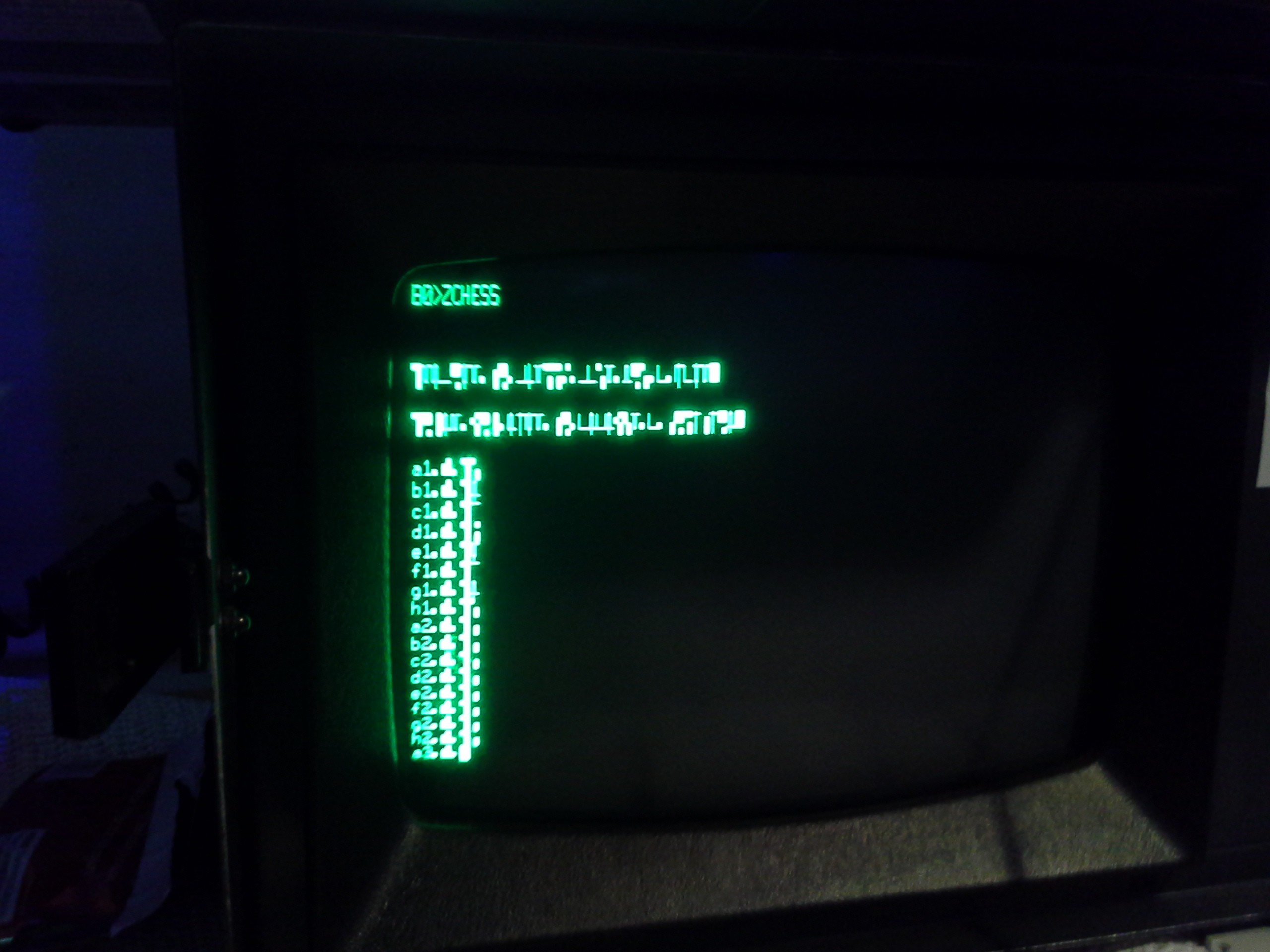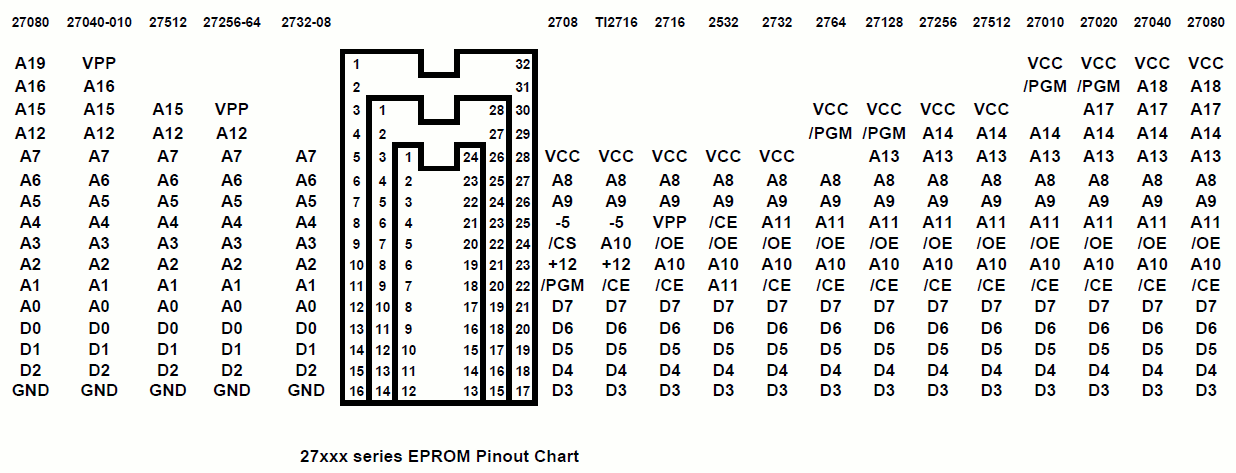
u9 appears to be the character ROM... there's a 2732 24 pin EPROM in the socket. Its contents is in the files section, and ziggurat29 decoded it into ascii art. It appears the Omni4 has a custom character set for drawing logic waveforms.
Ziggurat noted that the schematic shows pin 2, a12 is driven from somewhere... (where?). Well the 2732 doesn't have an a12, but the 2764 does... and the 2732 is pin-compatible-enough that it could be dropped in a 2764 socket, if said socket is designed with that intent... which this one is. And that explains the larger socket than the chip...

Ziggurat also noted some code in the bios that seems to support character-set switching (via a12, most likely)...
So my guess is that this was designed with the intent to support two character sets... a normal one for normal stuff... and switching to the custom one for the logic analyzer.
Seems logical.
So some tests run tonight:
A12 starts low, upon reset, but goes (and stays) high as soon as the boot title screen pops up... even before the disk is read, so before the os is loaded, and long before the logic analyzer software is loaded...
This seems backwards to me... certainly itit'd be more logical to use the default character set for boot, then switch charsets when loading la.com...
An easy change... for a designer... and another thing leading me to think this guy's a prototype (or they ran out of energy for such a simple change... with the assumption few people would be using a $4000 logic analyzer to play games?). While the change would be simple, it would require modifying both the bios and la.com (and any other related software)... so I can see how a backburner idea like that might've been abandoned...
So... since a12 isn't used on the 2732, and since the 2732 only contains the custom charset, the machine thinks its accessing the custom charset (immediately upon boot and always thereafter) in the higher address space of a 2764... but it's really wrapping around and accessing the lower address space, which is fit in a 2732.
So I guess... if this were something I cared to fix, like if i wanted to play games on this thing, I could load the custom charset in the higher addresses of a 2764 and the regular one in the lower space, as designed... then I'd need a utility to switch to the normal charset every time I wanted to play a game... which would mean not being able to just boot off any floppy.
Or... I could swap it from the presumed-intended design... have the custom charset in the low space and the normal one in the high space... this'd mean having a utility run before the la software to switch to the low space. Could do that in some sorta script, right?.. completely goofy, but a solution that would allow normal disks to boot with the normal charset.
Now... what if there are games, etc. That expect their own custom charset..? Or, maybe weirder, what if some programs reset to the default charset when starting... Who knows.
It definitely looks, though, as if this charset swapping is a thing designed in kaypro 2x's... not limited to the omni 4... but am guessing the choice to set a12 high in the bios is specific to the omni4...
Anyhow, a curiosity.
.....
Probing: A12CH appears to be connected to U58, PIN 16... heading back to the schematic... yep... there it is, sheet D just as it says... dunno how I missed it before.
.....
Replaced the second 5.25in drive with another 3.5... MUCH easier, now, to try out other software... (looking into something that'll transfer the disk contents faster and reliably for viewing on a newer computer).
Not sure where I stand with this thing... I'm starting to get hackish ideas... that can't end well... and... could be done with a normal kaypro, anyhow...
(Seriously: installing a soundblaster has crossed my mind a couple times... maybe I'd better get this thing out of my sight ASAP... I can do stuff like that with #Improbable AVR -> 8088 substitution for PC/XT instead of frankensteining one of the last of an endangered species)
...
Also... found a disk image online containing ebasic.com... yep. BASIC. so now can twiddle some bits... tried to read the RTC... it thinks it's April 1989. Spose it's possible it wrapped there after y2k... the time's way off. Otoh, no idea whether it was set in this time zone (or at all)... and I'm betting thirty minutes in either direction could easily been lost/gained in thirty years... thing is, the 3v battery still reads 2.7v... so it's probably still trying to keep time. But it seems funny these things even have RTCs... 'cause I haven't found any software that reads it, and certainly none to set it!
 Eric Hertz
Eric Hertz
Discussions
Become a Hackaday.io Member
Create an account to leave a comment. Already have an account? Log In.
please brodher study my hacking please
Are you sure? yes | no
please study my hacking brodher
Are you sure? yes | no
My mind is blown about the A12 being set high after boot. That's really weird; all the more so because it doesn't do anything as shipped.
'Soundblaster' haha. If you wanted to go retro (and cheap) you could use the printer port. Simple resistor network into an LM386. To wit, "Disney Sound Source" used the technique in a shipping product.
Are you sure? yes | no
"Disney sound source" was a rebrand of the Covox Voice Thing. The trick is that you have to use very, very high precision resistors and they have to be /matched/ -- the resistance has to be the same out to something like the third place past the decimal point, or you'll hear it.
IIRC, neither DSS nor CVT had internal /amplification/ though -- probably because they were to be powered /by/ the parallel port, which simply did not have the oomph for that. Further, there actually aren't too many games that support those things -- the game that is by far my favorite in the "needs DOS" category, most certainly does not... a pity, because I'd love to play it on my 486 laptop, except that that laptop is a deaf/mute by manufacture...
Are you sure? yes | no
I believe you're right about the external amp on the original units, but hence my suggestion of the LM386. I suspect you'd get not entirely horribly results with a non-precision R-2R ladder, and maybe a bigger concern is timing -- it would all be spin-waits on the Kaypro 2x -- no timer interrupts :( But still more fun than the beeper. (You won't believe what they used for the beeper on the Kaypro II (not the same unit as this one): a spare serial port TX line; haha!)
But now that I think of it, you could probably stick a DAC0808 (who doesn't have some laying around?) with veritably no interfacing, since the printer port is already latched. But still need an amp.
Correct, they were not that popular. I forgot about Covox! They had the cheek to want $70 for the thing, haha. Disney at least sold it for far less (and strapped on a little more hardware), and I think some titles even shipped with one as a value add. All those low-end gadgets became sort of a moot point (or 'mute' in this case? haha) around 1995, when basic sound hardware started being shipped on the mobo.
Are you sure? yes | no
pretty impressive, really, that the sound'd be very good on those things, essentially playing wav files on such ancient hardware... but I've definitely looked into them in the past.
But actually I was thinking about experimenting with fm synthesis... and there's really no reason not to use that as an excuse to finalize this thing and return to the pc/xt project... in light of not Frankensteining this rarity...
Are you sure? yes | no